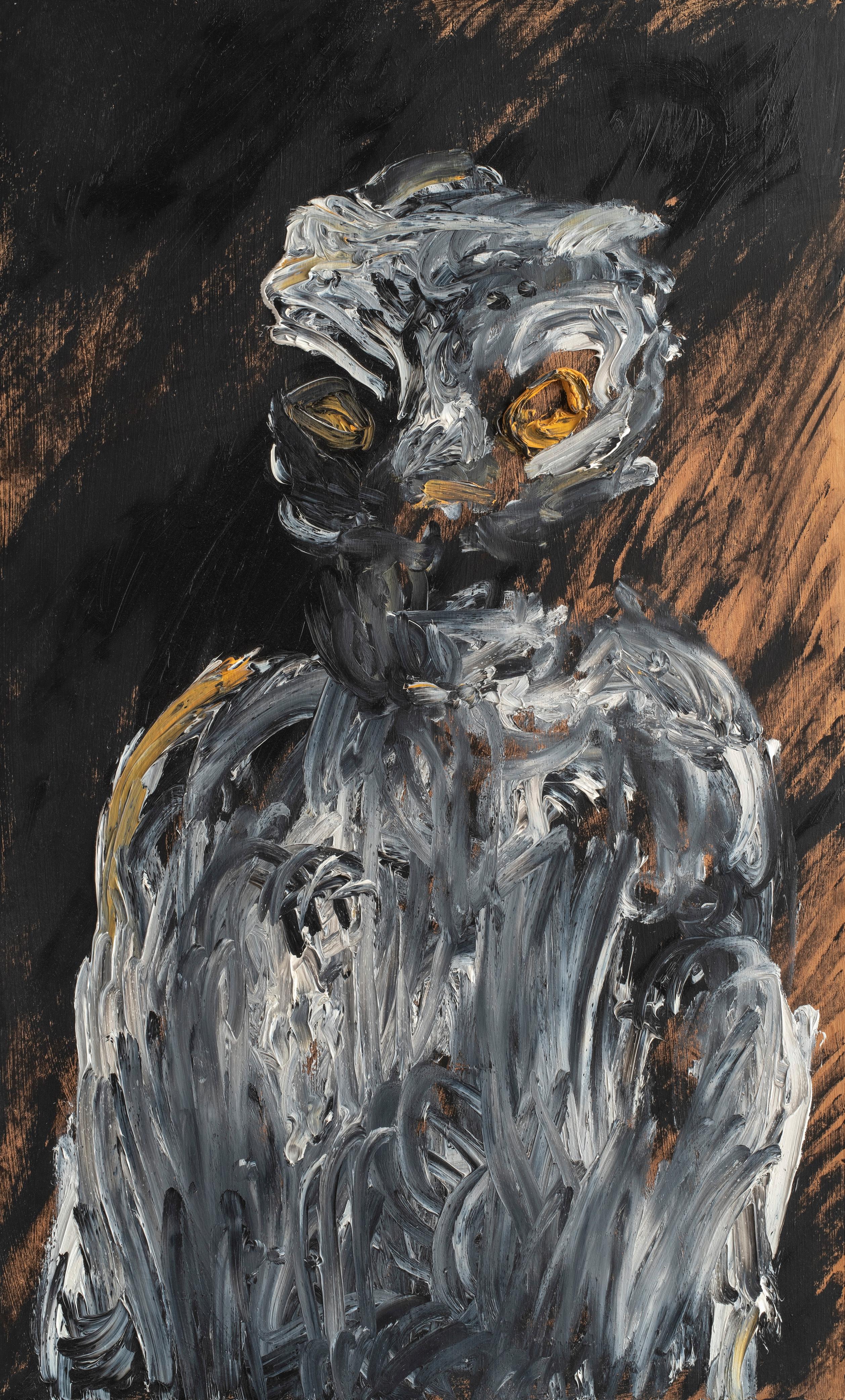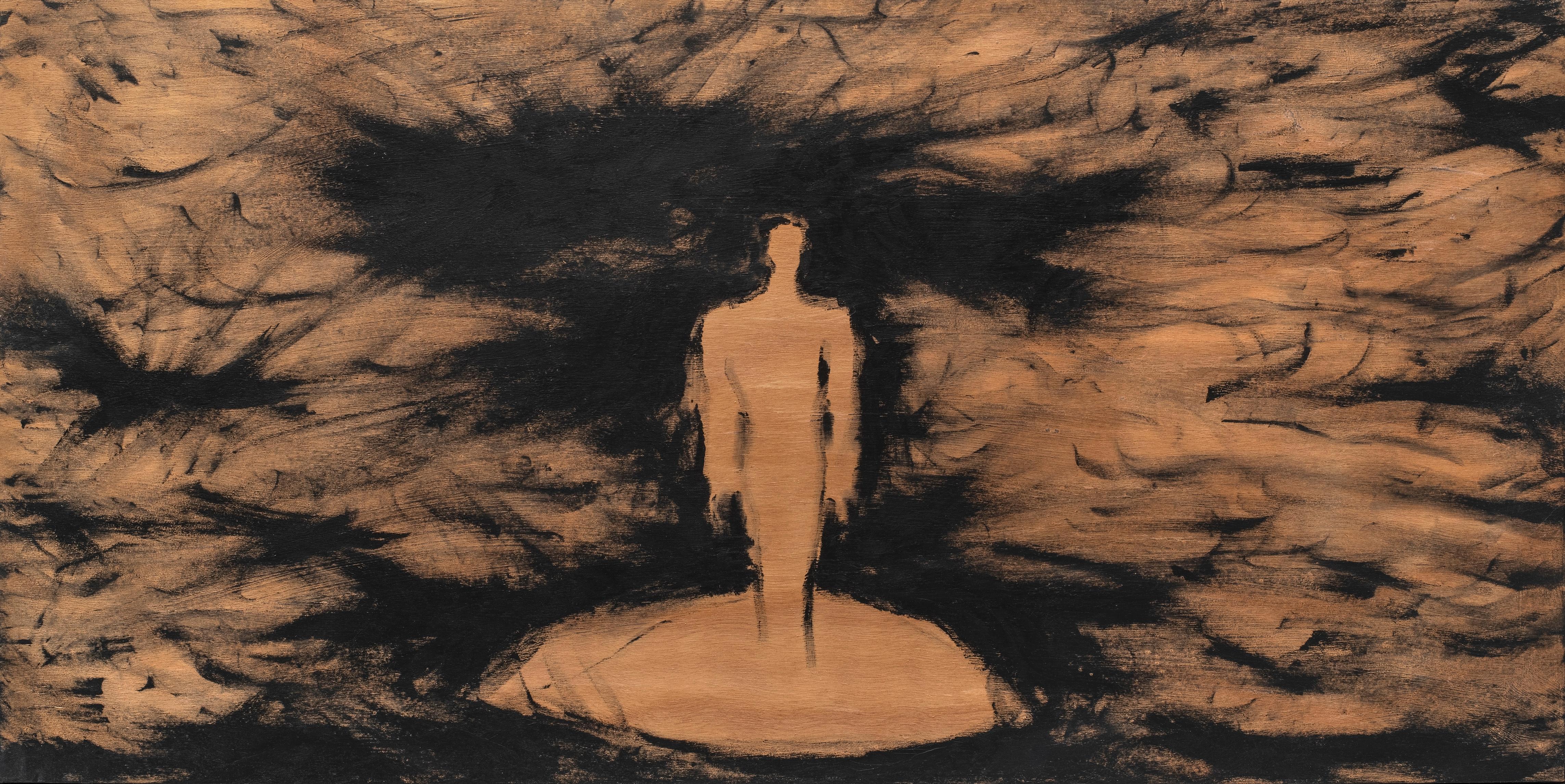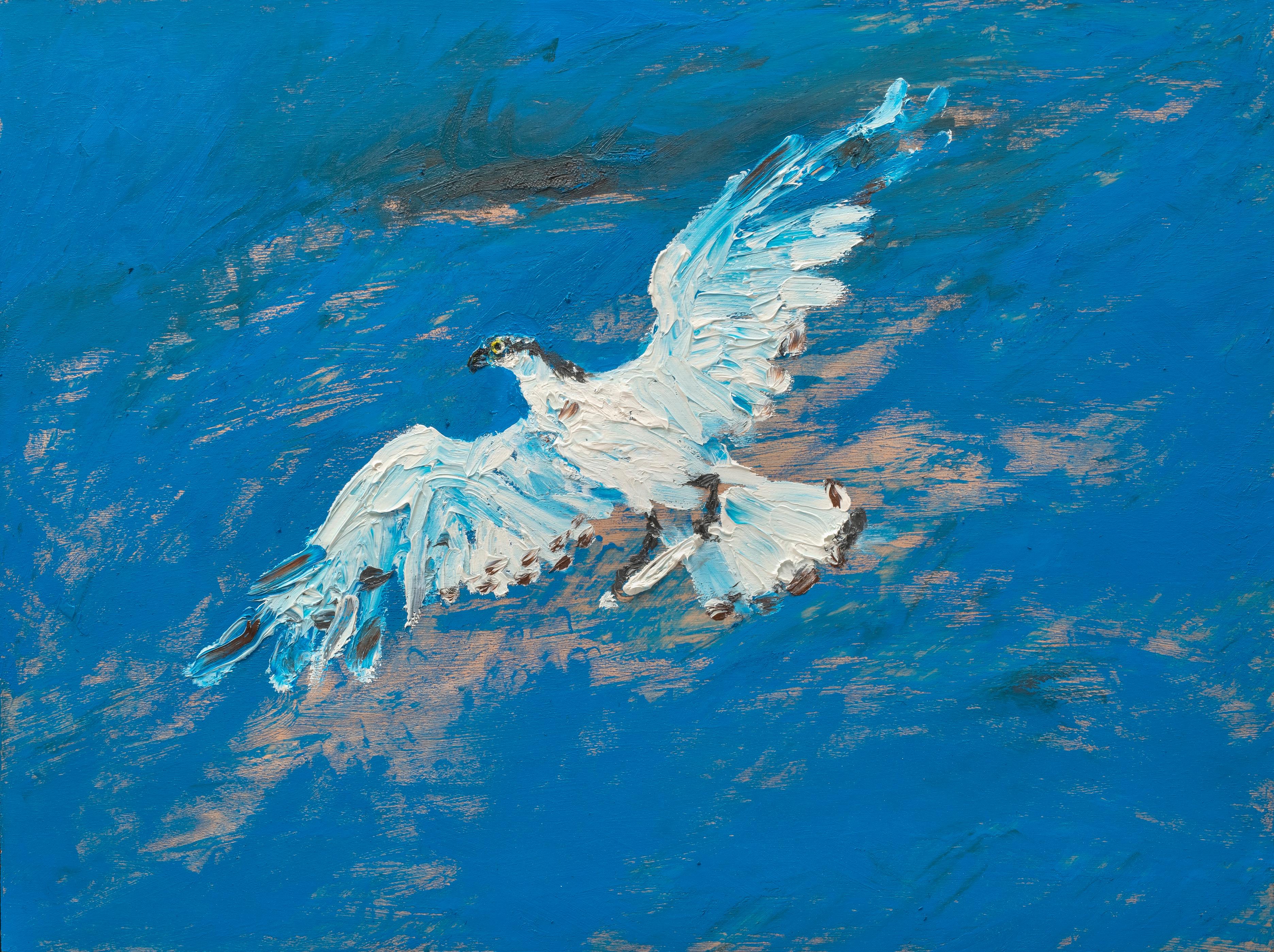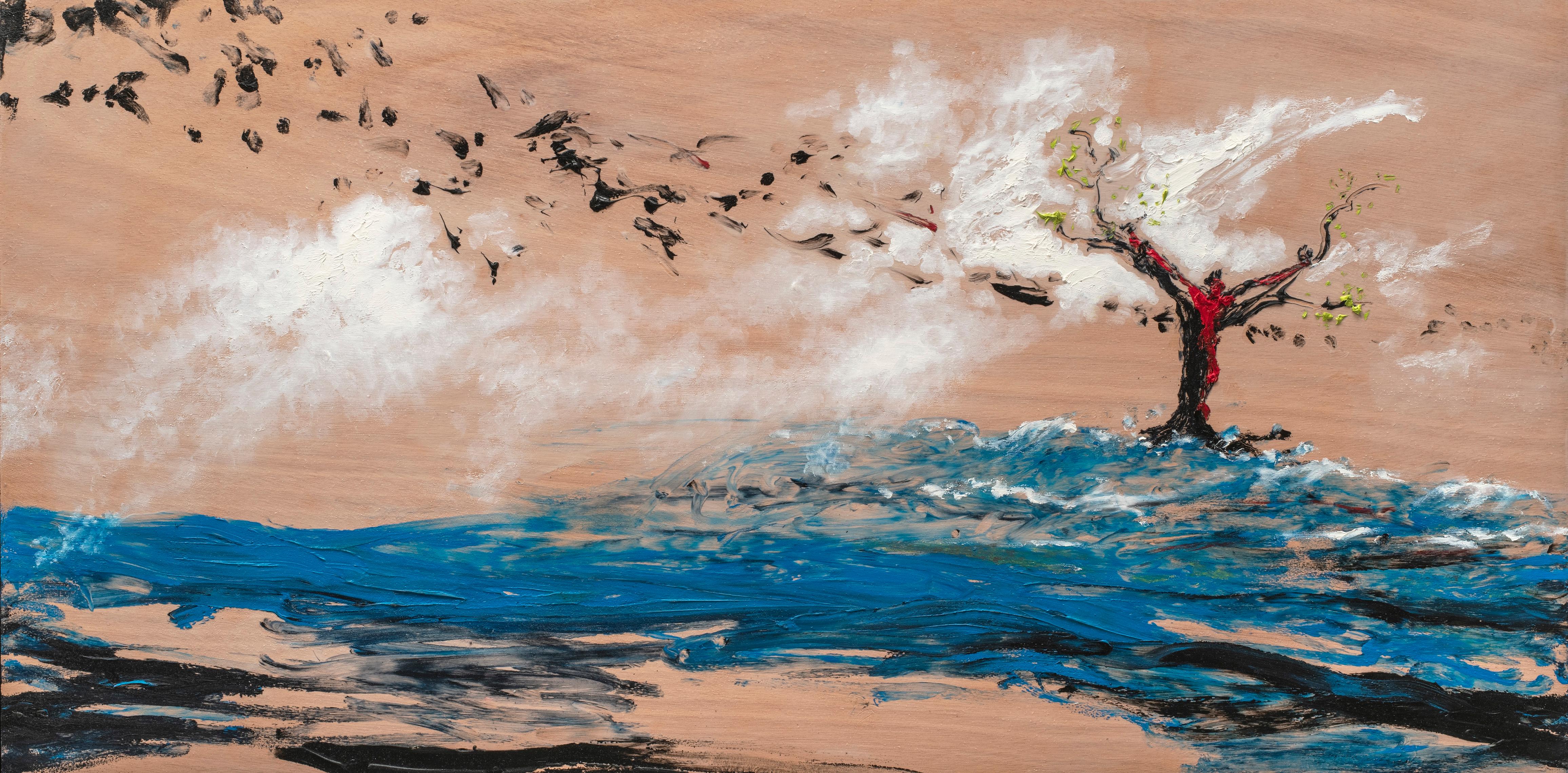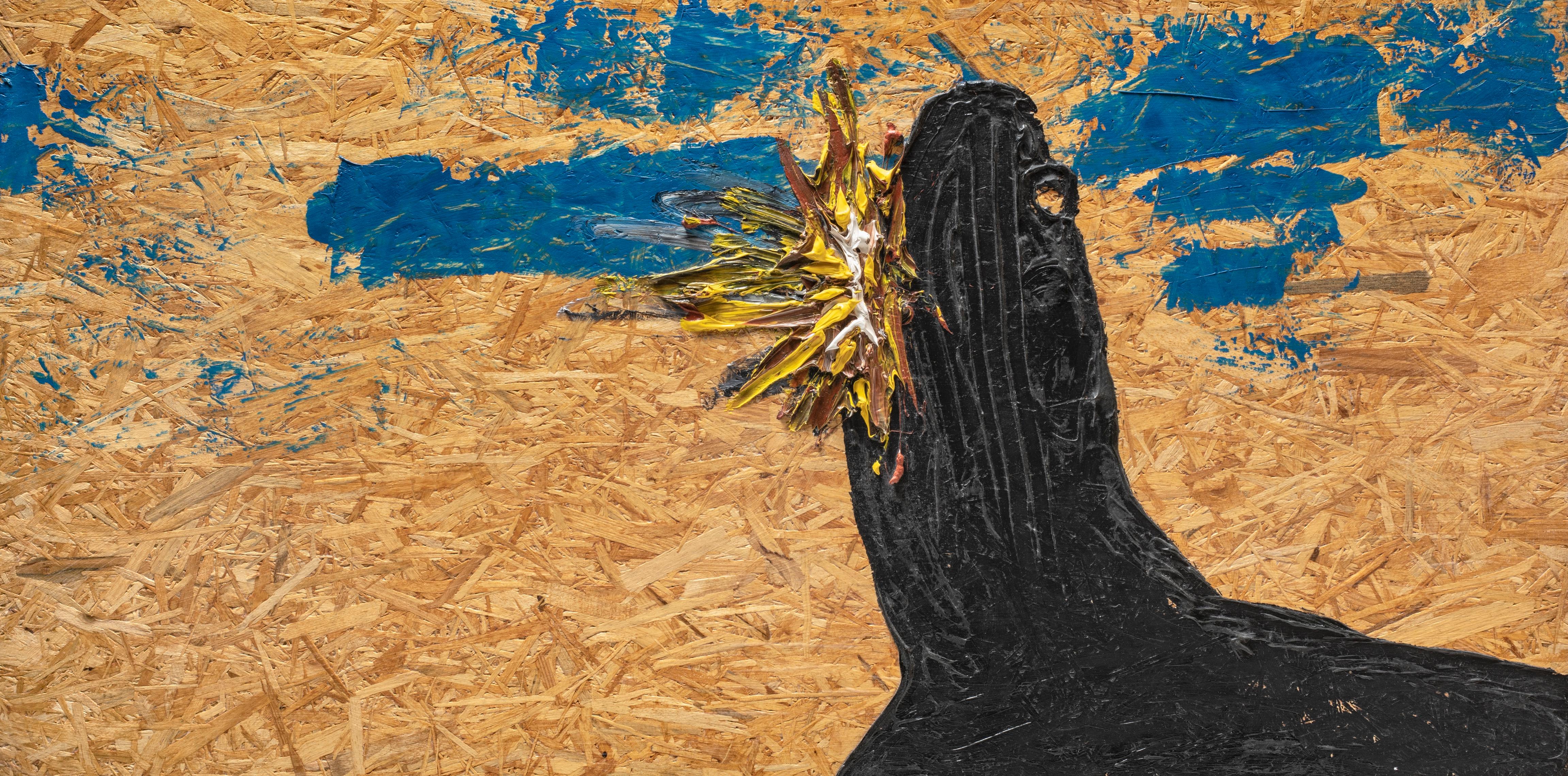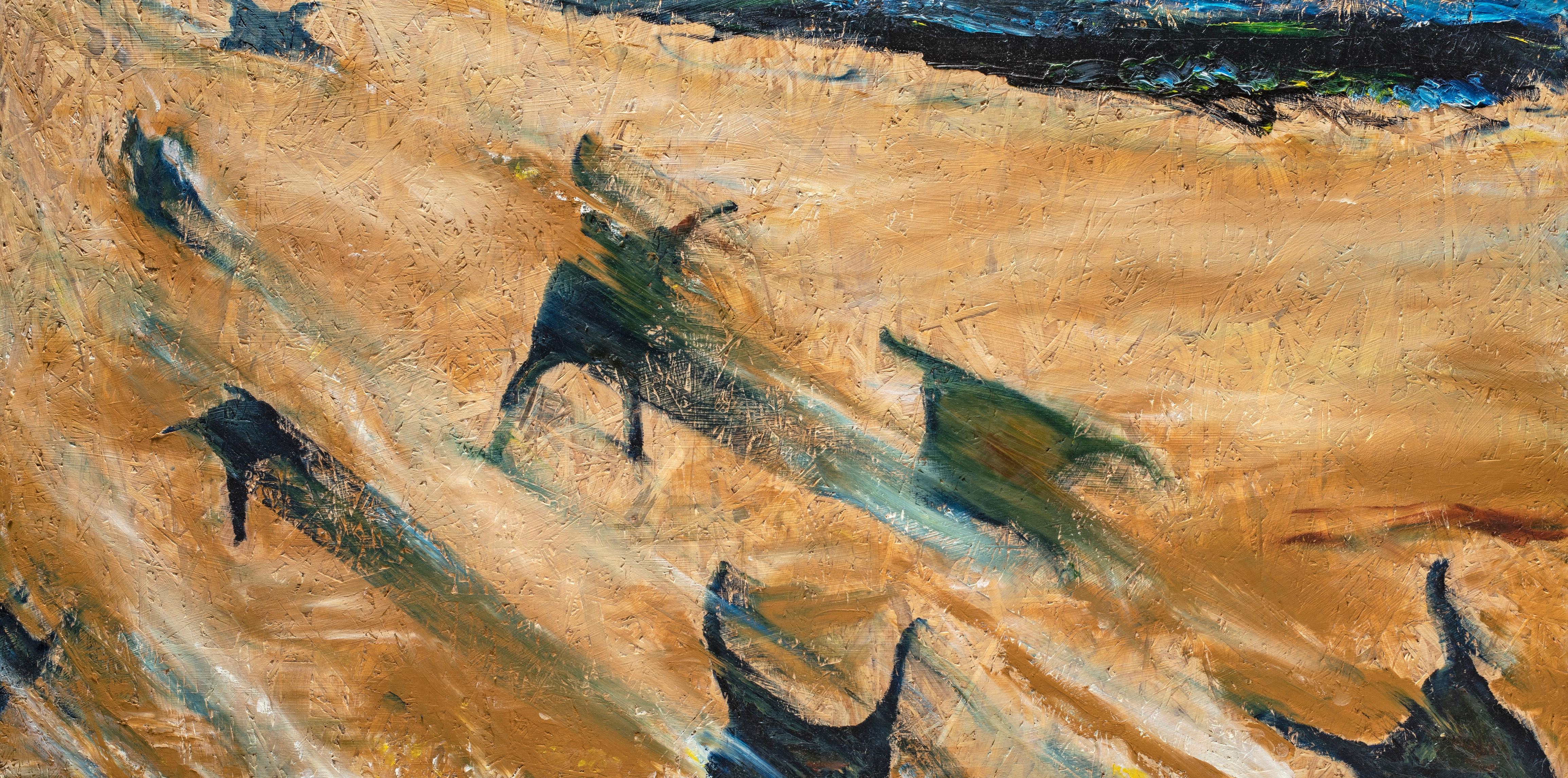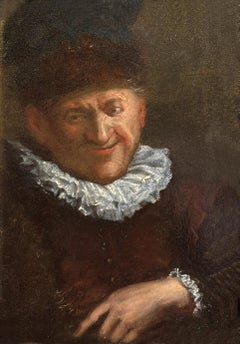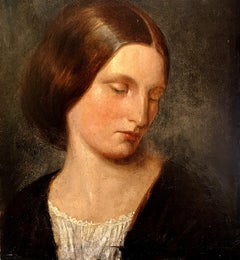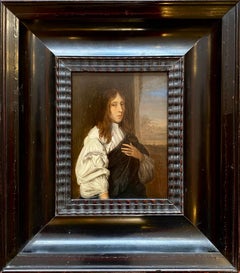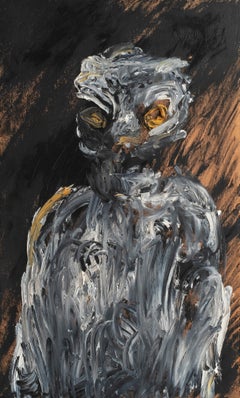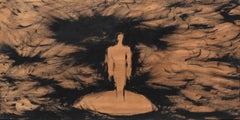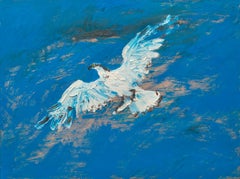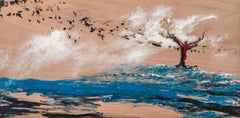Items Similar to Harem Girl with Tambourine
Want more images or videos?
Request additional images or videos from the seller
1 of 5
Antonio Maria Fabrés y CostaHarem Girl with Tambourine
About the Item
Antonio Maria Fabres y Costa
Harem Girl with a Tambourine
1854-1938
Oil on panel, signed lower right
Image Size: 21 3/4 x 18 inches (55.1 x 45.7 cm)
This painting exudes decadence and exoticism, marking it as a work that epitomises the Orientalist movement. It depicts a beautiful lady dressed in a kaftan and silken scarves - her fingers, wrists and neck are adorned with a variety of jewels, gold and silver, and she is also wearing a traditional coin headdress. This lady is evidently incredibly wealthy, further evidenced by the expensive fabrics that surround her on the daybed and the leopard skin rug on the floor - this plays into the Orientalist trope of wealthy and bejewelled Arabic and Maghrebi cultures. She is also culturally wealthy, as demonstrated by the dutar and tambourine, and the way her mouth is slightly ajar as if she is singing. Her surroundings depict traditional Middle Eastern architecture, such as silverware lamps, geometrically patterned tiles, and rounded archways. A beautiful display of fresh flowers snaked up a column in the left side of the image, adding a sense of gentle femininity to the work.
The painting is in Costa’s acclaimed realistic style, with attention paid to every last detail. No area of the image is lacking, from the individual leaves of the flowers, to the fabric patterns on the cushions, to the highly detailed calligraphic border on the daybed. The work is intended to appeal to the European market of the 19th century, which desired ‘realistic’ depictions of idealised and archetypal ‘exotic’ cultures from newly gained territories in the Middle East and North Africa.
Antonio Maria Fabres y Costa
Antonio Maria Fabred y Costa was born in Barcelona in 1854, the son of a drawing teacher. Costa was talented at drawing and his father began to tutor him. He spent some time in the studio of the sculptor Aleu i Teixidor and began to study sculpture at the Saint Jordi Academy in 1867. He won an award for a bust of one of his uncles, and eventually won a scholarship to study in Rome in 1875.
In Rome, Costa became acquainted with and heavily influenced by Mariano Fortuny and Jose Villegas. He turned away from sculpture as a medium and began to paint, becoming well known for his intense realism. His works were immensely popular with the upper classes, who appreciated his exotic and orientalist themes. This popularity enabled Costa to open a studio, which greatly increased his output and earned him international recognition.
During this time, Costa also became renowned for his watercolours, which he exhibited in Madrid in 1881 and 1882 to great commercial success. These watercolours were exhibited continuously throughout the 1880s, and were even given as a gift for Queen Maria Cristina and the Imperial Princess of Germany when they visited the Court. In 1886, Costa returned to Barcelona, and continued to exhibit watercolours in Madrid before expanding to Munich, where he won a Gold Medal in 1888.
After the death of his mother in 1894, Costa relocated to Paris and became acquainted with a number of orientalist artists. His fame grew exponentially with the help of dealer Goupil, who marketed Costa’s works as in direct succession to the immensely popular Fortuny. Costa began to exhibit at different salons around the world, winning an Honourable Mention at the Paris Salon in 1895, a Second Medal in 1896, and Silver Medals at the 1900 Universal Exhibition, the 1901 Salon and the 1902 Lyon Exhibition. During his time in France, Costa had formed a friendship with Mexican sculptor Jesus Contreras, who convinced him to become the head of the painting department at the Academy of San Carlos in Mexico City.
Costa relocated to Mexico in 1902, where he was both the head of the painting department and the deputy director of the Academy itself. He was also appointed Inspector General of Fine Arts Mexico by the President, and held responsibility for organising the capital’s museum. However, Costa often found himself at odds with the abstraction of the artistic scene in Mexico and returned to Rome in 1907 - his students later developed the Post-Revolutionary Movement, and many were muralists.
Returning to Europe, Costa continued exhibiting at Salons and Exhibitions globally, building a reputation in London, Vienna, Paris, Lyon, Barcelona, and even as far abroad as America. He participated in the 1910 Venice Biennale, as well as the commemoration for the 50th anniversary of Italian reunification. In 1916, he was commissioned by Pope Benedict XV to paint his portrait, which was later hung in the Vatican Museum. In 1925, Costa donated a number of his works to the Museum of Fine Arts in Barcelona in exchange for a hall in his name - the Museum took the works, but never built the hall. Costa was declared Commander of the Order of the Crown of Italy and became the honorary president of the Association of Watercolourists of Catalonia.
He died in Rome in 1938, leaving a legacy as a fierce orientalist whose methods and style inspired and influenced artists across the globe.
- Creator:Antonio Maria Fabrés y Costa (1854 - 1938, Spanish)
- Dimensions:Height: 21.7 in (55.1 cm)Width: 18 in (45.7 cm)
- Medium:
- Period:
- Condition:
- Gallery Location:London, GB
- Reference Number:1stDibs: LU52416437002
About the Seller
5.0
Vetted Professional Seller
Every seller passes strict standards for authenticity and reliability
Established in 2007
1stDibs seller since 2014
80 sales on 1stDibs
Typical response time: 1 hour
- ShippingRetrieving quote...Shipping from: London, United Kingdom
- Return Policy
Authenticity Guarantee
In the unlikely event there’s an issue with an item’s authenticity, contact us within 1 year for a full refund. DetailsMoney-Back Guarantee
If your item is not as described, is damaged in transit, or does not arrive, contact us within 7 days for a full refund. Details24-Hour Cancellation
You have a 24-hour grace period in which to reconsider your purchase, with no questions asked.Vetted Professional Sellers
Our world-class sellers must adhere to strict standards for service and quality, maintaining the integrity of our listings.Price-Match Guarantee
If you find that a seller listed the same item for a lower price elsewhere, we’ll match it.Trusted Global Delivery
Our best-in-class carrier network provides specialized shipping options worldwide, including custom delivery.More From This Seller
View AllPortrait of a Man, 17th Century Dutch Oil on Panel Portrait
By Cornelis Dusart
Located in London, GB
Circle of Cornelis Dusart
Dutch 1660 - 1704
Portrait of a Man
Oil on panel
Image size: 7¾ x 5¼ inches
Giltwood frame
Cornelis Dusart
Cornelis ...
Category
17th Century Old Masters Portrait Paintings
Materials
Oil, Panel
Portrait of William Herbert, 3rd Earl of Pembroke, Early 17th Century Portrait
Located in London, GB
English School, (circa 1600)
Portrait of William Herbert, 3rd Earl of Pembroke
Oil on panel, oval
Image size: 29¼ x 23⅞ inches
Painted wooden frame
Provenance:
176, Collection of Francis Greville, 1st Earl of Warwick.
The Trustees of the Lord Brooks’ Settlement, (removed from Warwick Castle).
Sotheby’s, London, 22nd March 1968, lot 81.
Painted onto wooden panel, this portrait shows a dark haired gentleman in profile sporting an open white shirt. On top of this garments is a richly detailed black cloak, decorated with gold thread and lined with a sumptuous crimson lining. With the red silk inside it’s all very expensive and would fall under sumptuary laws – so this is a nobleman of high degree.
It’s melancholic air conforms to the contemporary popularity of this very human condition, evident in fashionable poetry and music of the period. In comparison to our own modern prejudices, melancholy was associated with creativity in this period.
This portrait appeared in the earliest described list of pictures of Warwick castle dating to 1762. Compiled by collector and antiquary Sir William Musgrave ‘taken from the information of Lord & Lady Warwick’ (Add. MSS, 5726 fol. 3) is described;
‘8. Earl of Essex – an original by Zuccharo – seen in profile with black hair. Holding a black robe across his breast with his right hand.’
As tempting as it is to imagine that this is a portrait of Robert Devereux, the 2nd Earl Essex, we might take this with a pinch of salt. Its identification with this romantic and fatal Elizabethan might well have been an attempt to add romance to Warwick Castle’s walls. It doesn’t correspond all that well with Essex’s portraits around 1600 after his return from Cadiz. Notably, this picture was presumably hung not too far away from the castle’s two portraits of Queen Elizabeth I. The first, and undoubtedly the best, being the exquisite coronation portrait that was sold by Lord Brooke in the late 1970s and now hangs in the National Portrait Gallery. The second, described as being ‘a copy from the original at Ld Hydes’, has yet to resurface.
The portrait eventually ended up being hung in the State Bedroom of Warwick Castle.
Archival documents present one other interesting candidate. The Greville family’s earliest inventory of paintings, made in 1630 at their home Brooke House in Holborn, London, describes five portraits of identified figures. All five belonged to the courtier, politician and poet Sir Fulke Greville (1554-1628), 1st Baron Brooke, and were hung in the ‘Gallerie’ of Brooke House behind yellow curtains. One of them was described as being of ‘Lord of Pembrooke’, which is likely to have been William Herbert (1580-1630), 3rd Earl of Pembroke. William was the eldest son of Greville’s best friend’s sister Mary Sidney, and was brought up in the particularly literary and poetically orientated household which his mother had supported. Notably, the 3rd Earl was one of the figures that Shakespeare’s first folio was dedicated to in 1623.
The melancholic air to the portrait corresponds to William’s own pretensions as a learned and poetic figure. The richness of the robe in the painting, sporting golden thread and a spotted black fabric, is indicative of wealth beyond that of a simple poet or actor. The portrait’s dating to around the year 1600 might have coincided with William’s father death and his own rise to the Pembroke Earldom. This period of his life too was imbued with personal sadness, as an illicit affair with a Mary Fitton had resulted in a pregnancy and eventual banishment by Elizabeth I to Wilton after a short spell in Fleet Prison. His illegitimate son died shortly after being born. Despite being a close follower of the Earl of Essex, William had side-stepped supporting Devereux in the fatal uprising against the Queen and eventually regained favour at the court of the next monarch James I.
His linen shirt is edged with a delicate border of lace and his black cloak is lined on the inside with sumptuous scarlet and richly decorated on the outside with gold braid and a pattern of embroidered black spots.
Despite the richness of his clothes, William Herbert has been presented in a dishevelled state of semi-undress, his shirt unlaced far down his chest with the ties lying limply over his hand, indicating that he is in a state of distracted detachment. It has been suggested that the fashion for melancholy was rooted in an increase in self-consciousness and introspective reflection during the late 16th and early 17th centuries.
In contemporary literature melancholy was said to be caused by a plenitude of the melancholy humor, one of the four vital humors, which were thought to regulate the functions of the body. An abundance of the melancholia humor was associated with a heightened creativity and intellectual ability and hence melancholy was linked to the notion of genius, as reflected in the work of the Oxford scholar Robert Burton, who in his work ‘The Anatomy of Melancholy’, described the Malcontent as ‘of all others [the]… most witty, [who] causeth many times divine ravishment, and a kind of enthusiamus… which stirreth them up to be excellent Philosophers, Poets and Prophets.’ (R. Burton, The Anatomy of Melancholy, London, 1621 in R. Strong, ‘Elizabethan Malady: Melancholy in Elizabethan and Jacobean Portraits’, Apollo, LXXIX, 1964).
Melancholy was viewed as a highly fashionable affliction under Elizabeth I, and her successor James I, and a dejected demeanour was adopted by wealthy young men, often presenting themselves as scholars or despondent lovers, as reflected in the portraiture and literature from this period. Although the sitter in this portrait is, as yet, unidentified, it seems probable that he was a nobleman with literary or artistic ambitions, following in the same vain as such famous figures as the aristocratic poet and dramatist, Edward de Vere...
Category
Early 17th Century Old Masters Portrait Paintings
Materials
Oil, Wood Panel
Portrait of a Mary Hardy (nee Sulman), Late 19th Century Victorian Oil
Located in London, GB
Slade School
Late 19th Century
Portrait of a Mary Hardy (nee Sulman)
Oil on panel
Image size: 8 x 7 inches
Contemporary frame
Provenance
Lady Town (Grandda...
Category
Late 19th Century Victorian Portrait Paintings
Materials
Oil, Panel
Portrait of a Young Man - 17th Century Portrait in Oil
By Pieter Harmensz Verelst
Located in London, GB
Circle of Pieter Harmensz Verelst
1618 - 1678
Portrait of a Young Man
Oil on oak panel
Image size: 7 ½ x 5 ¾ inches
Dutch ripple frame
Category
18th Century and Earlier Old Masters Portrait Paintings
Materials
Oil, Panel
Portrait of a Boy in a Black Tunic - Early 17th Century Oil
Located in London, GB
Flemish School, Early 17th Century
Portrait of a Boy in a Black Tunic
Oil on panel
Image size: 15¾ x 13⅛ inches
This accomplished portrait of an unknown boy in his early teens was p...
Category
17th Century Portrait Paintings
Materials
Oil, Panel
A decorative oval relief with Venus and Cupid, 18th Century Rococo Oil
By Jacob De Wit
Located in London, GB
Follower of Jacob de Wit
1695-1754
Venus and Cupid
Oil on panel
Image size: 7 ¾ inches x 11 ¾ inches
Gilt frame
A charming example of trompe-l'œil, this painting is abrim with...
Category
18th Century Rococo Figurative Paintings
Materials
Oil, Panel
You May Also Like
Lynx speak Nicolas Kennett 21st Century Bristish painting portrait expressionist
Located in Paris, FR
Oil paint on wood panel
Signed on the back
"Incanto" or the enchantment of shifting
"Nicolas Kennett revisits the organic world through painted and sc...
Category
2010s Expressionist Figurative Paintings
Materials
Oil, Wood Panel
Beyond Nicolas Kennett 21st Century British painting character skyscape black
Located in Paris, FR
Oil paint on wood panel
Signed on the back
Category
2010s Contemporary Figurative Paintings
Materials
Oil, Wood Panel
Osprey Nicolas Kennett 21st Century British painting bird of prey animal sky
Located in Paris, FR
Oil paint on wood panel
Signed on the back
Category
2010s Contemporary Figurative Paintings
Materials
Oil, Wood Panel
Hanging Nicolas Kennett 21st Century British painting landscape tree flowers sky
Located in Paris, FR
Oil paint on wood panel
Signed on the back
"Incanto" or the enchantment of shifting
"Nicolas Kennett revisits the organic world through painted and sculpted matter. He oscillates b...
Category
2010s Contemporary Figurative Paintings
Materials
Oil, Wood Panel
Eclipse Nicolas Kennett 21st Century British painting animal blue wild mystery
Located in Paris, FR
Oil paint on wood panel
Signed on the back
"Incanto" or the enchantment of shifting
"Nicolas Kennett revisits the organic world through painted and s...
Category
2010s Contemporary Figurative Paintings
Materials
Oil, Wood Panel
Incanto Nicolas Kennett 21st Century Bristish painting landscape cave animal
Located in Paris, FR
Oil paint on wood panel
Signed on the back
"Incanto" or the enchantment of shifting
"Nicolas Kennett revisits the organic world through painted and s...
Category
2010s Contemporary Landscape Paintings
Materials
Oil, Wood Panel
